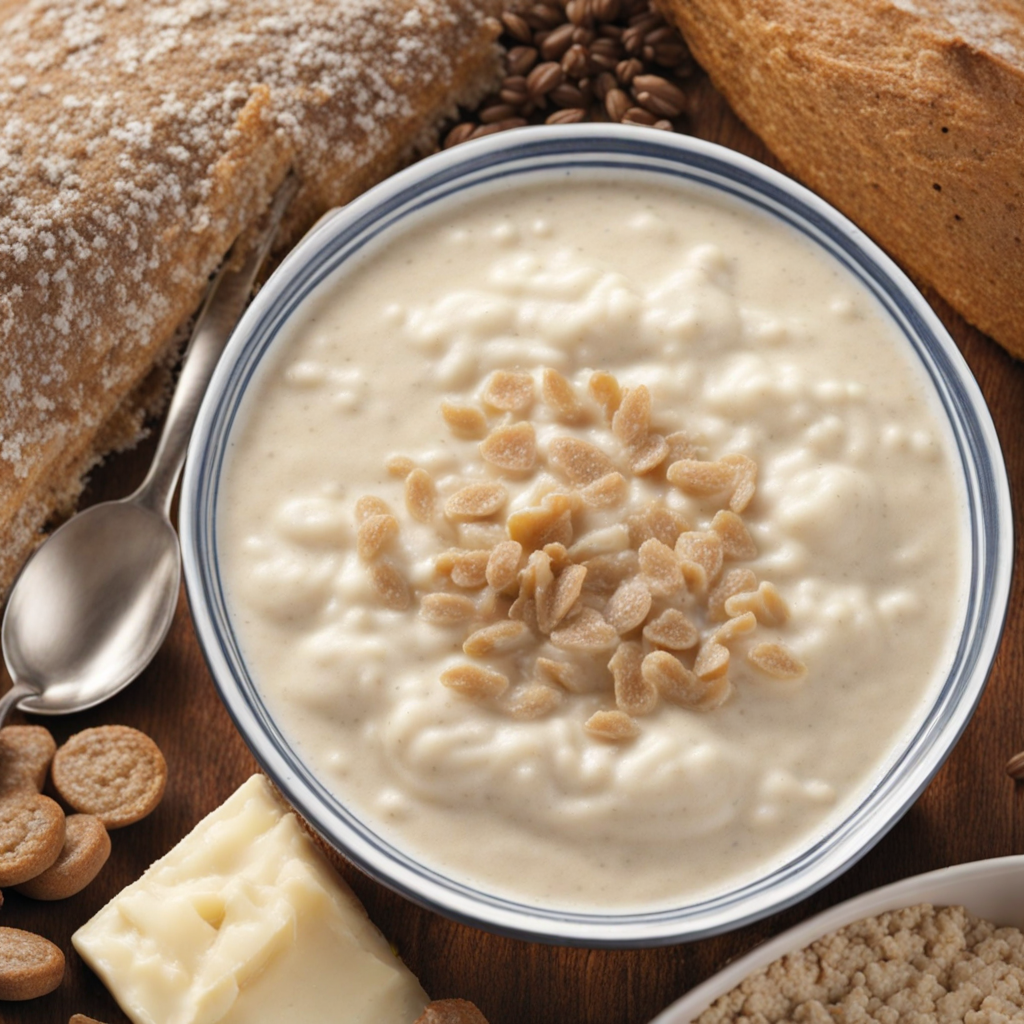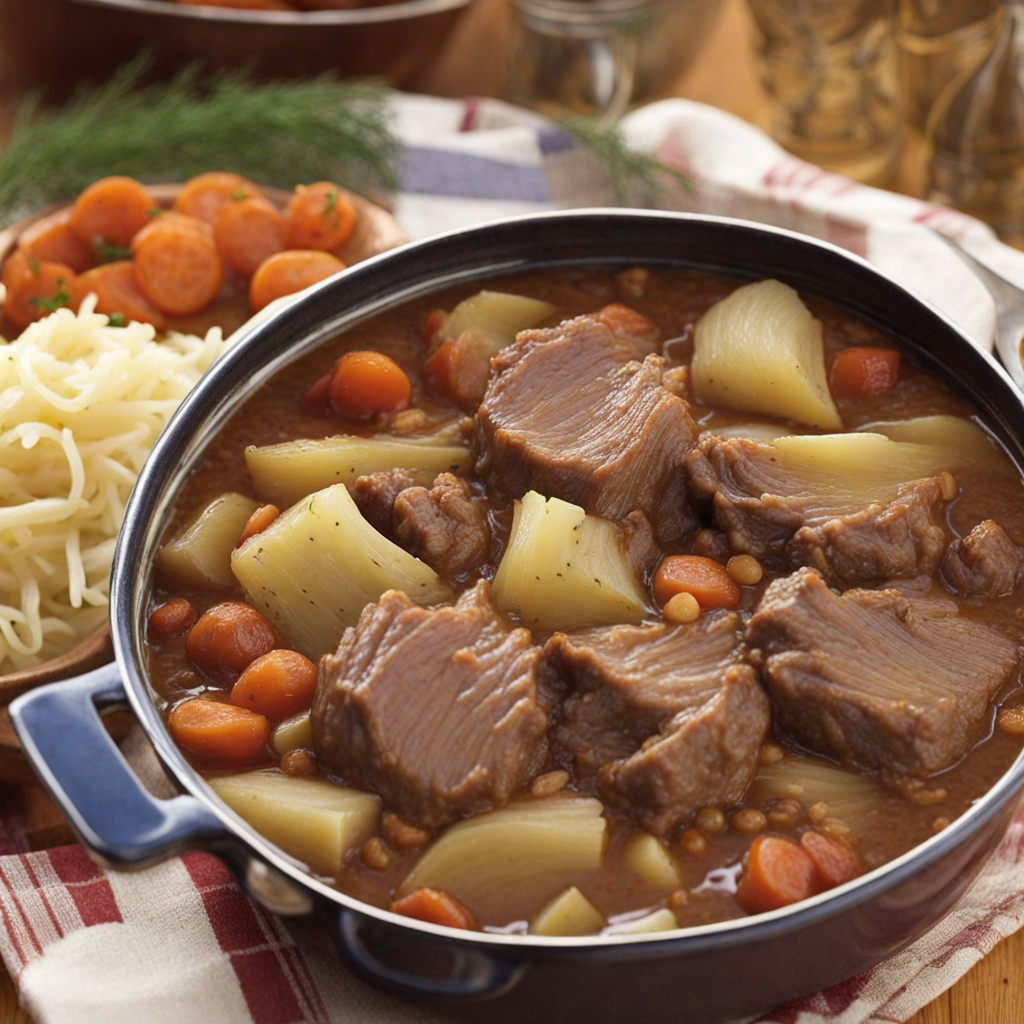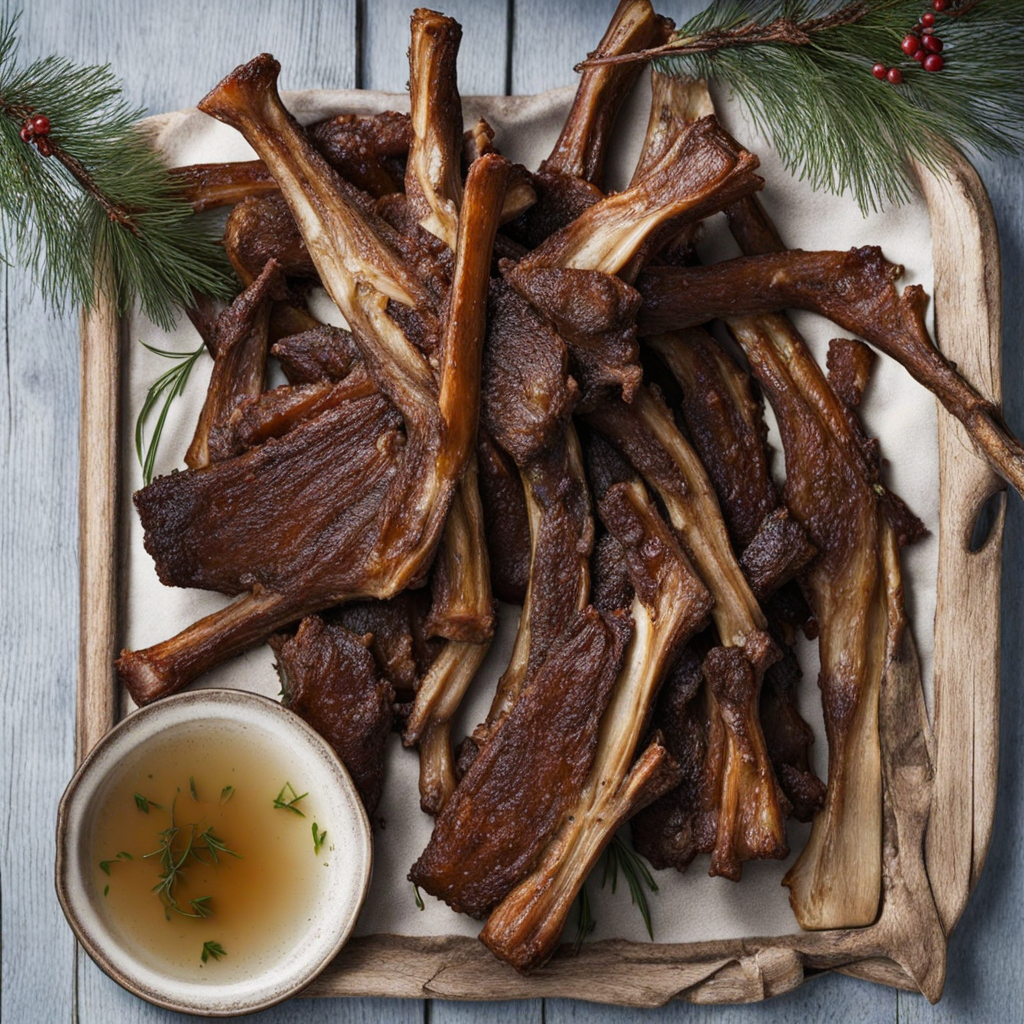Rømmegrøt
Rømmegrøt is a traditional Norwegian dish, essentially a rich and creamy porridge made primarily from sour cream, flour, and milk. Its roots can be traced back to the Middle Ages, when it was commonly prepared for special occasions and celebrations, particularly during the summer months. Historically, rømmegrøt was associated with the dairy farming culture of Norway, where the use of sour cream was prevalent due to the abundance of dairy products. It was often served during festive gatherings, weddings, and other significant events, symbolizing prosperity and abundance. The flavor of rømmegrøt is distinctly rich and creamy, with a delightful tang from the sour cream that balances the sweetness of the dish. The texture is velvety and smooth, making it incredibly comforting. Traditionally, rømmegrøt is served warm, which enhances its luxurious mouthfeel. The dish is often accompanied by a sprinkling of cinnamon and sugar, adding an aromatic sweetness that complements the creamy base. Some variations also include a pat of butter melted on top, which further enriches the flavor profile, giving it a decadent finish. Preparation of rømmegrøt is relatively straightforward but requires careful attention to achieve the desired consistency and flavor. The key ingredients are sour cream, all-purpose flour, milk, and a pinch of salt. To begin, the sour cream is heated gently in a saucepan, and flour is gradually whisked in to create a roux. This mixture is then cooked for a few minutes to
How It Became This Dish
Rømmegrøt: A Culinary Journey Through Norway’s Cultural Heritage Origins and Historical Context Rømmegrøt, a traditional Norwegian porridge, has its roots deeply embedded in the agrarian lifestyle of Norway, particularly among the farming communities in the rural regions. The name "Rømmegrøt" translates to "sour cream porridge," which aptly describes its primary ingredient: rømme, a type of sour cream that is rich and thick. This dish is believed to have originated in the Middle Ages, around the 14th century, when dairy farming became a cornerstone of Norwegian agriculture. The use of sour cream in cooking was a way to preserve the milk from cows, which were often kept for their dairy products rather than for meat. The fermentation process not only extended the shelf life of the dairy but also imparted a unique flavor that defined many traditional Norwegian dishes. Rømmegrøt, along with other dairy-based foods, became a staple in the diet of rural Norwegians, especially during the summer months when milk production peaked. Cultural Significance Rømmegrøt holds a special place in Norwegian culture, often associated with festivities and communal gatherings. Traditionally, it was served during major celebrations and festivals, particularly during Christmas and Midsummer celebrations. The dish symbolizes hospitality and generosity; serving Rømmegrøt to guests is seen as a gesture of goodwill. Moreover, Rømmegrøt is often accompanied by "sugar and cinnamon," a classic topping that enhances its rich, creamy flavor. In some regions, it is also served with a dollop of melted butter, which adds a luxurious texture to the dish. It is not uncommon for Rømmegrøt to be part of a larger meal, often enjoyed alongside cured meats or flatbreads, creating a hearty and satisfying spread. The dish also plays a role in Norwegian folklore, often depicted in stories and songs that celebrate the simplicity and beauty of rural life. It is a symbol of home and comfort, evoking memories of family gatherings and shared meals. The preparation of Rømmegrøt is often a communal activity, with family members coming together to make the dish, further strengthening its ties to cultural identity. Development Over Time As Norway moved through the centuries, Rømmegrøt evolved, adapting to changes in agricultural practices, food availability, and societal norms. The Industrial Revolution in the 19th century brought about significant changes in food production, including the introduction of more commercial dairy products. While traditional recipes often required the labor-intensive process of making sour cream from scratch, the availability of store-bought sour cream made Rømmegrøt more accessible to the average household. Throughout the 20th century, as urbanization increased and people moved from rural areas to cities, Rømmegrøt transitioned from a staple of rural cuisine to a dish celebrated in urban centers as well. It became a symbol of nostalgia, a way for Norwegians living in cities to connect with their roots and traditions. Cookbooks began to feature Rømmegrøt alongside other traditional dishes, ensuring its place in the national culinary repertoire. The rise of the food movement in the late 20th and early 21st centuries has further revitalized interest in traditional foods like Rømmegrøt. Chefs and home cooks alike have embraced the dish for its simplicity and authenticity, often experimenting with modern twists while respecting its historical roots. Today, Rømmegrøt can be found not only in homes but also in restaurants that focus on traditional Norwegian cuisine, showcasing the dish to both locals and tourists. Modern Interpretations and Variations In contemporary Norwegian cuisine, Rømmegrøt is often served in conjunction with other traditional dishes during festive occasions, such as the Norwegian National Day (17th of May) and Christmas. It remains a favorite among families, often prepared as a treat during the summer months when the dairy is freshest. While the classic recipe remains popular, variations have emerged, reflecting changes in dietary preferences and the availability of ingredients. Some cooks have begun incorporating different grains, such as barley or oats, into Rømmegrøt, offering a twist on the traditional rice or wheat-based versions. Additionally, the rise of the farm-to-table movement has encouraged a more sustainable approach to food. Many chefs are now sourcing local ingredients and emphasizing organic, high-quality dairy products in their Rømmegrøt preparations. This trend not only supports local farmers but also promotes a deeper connection to the food and its origins. Conclusion: A Dish of Heritage and Identity Rømmegrøt is more than just a dish; it is a testament to Norway’s rich agricultural history and cultural identity. From its humble beginnings as a sustenance food in rural farming communities to its status as a cherished symbol of Norwegian hospitality, Rømmegrøt has transcended generations, adapting to the changing tides of society while maintaining its essence. As Norway continues to evolve, Rømmegrøt serves as a reminder of the importance of tradition, community, and the simple joys of sharing food with loved ones. Whether enjoyed during a festive gathering or as a comforting treat on a quiet evening, Rømmegrøt remains a beloved staple, bridging the past with the present and celebrating the enduring legacy of Norwegian culinary heritage.
You may like
Discover local flavors from Norway







